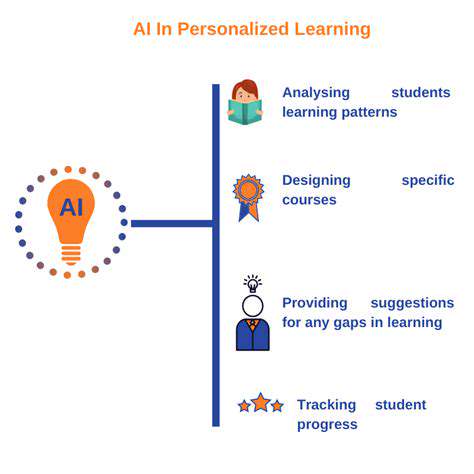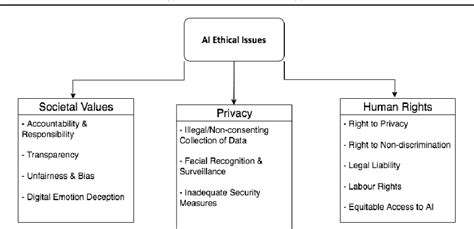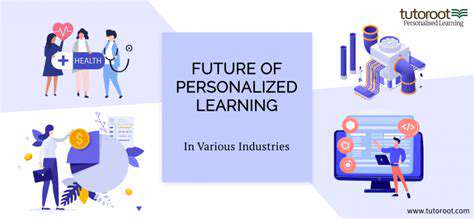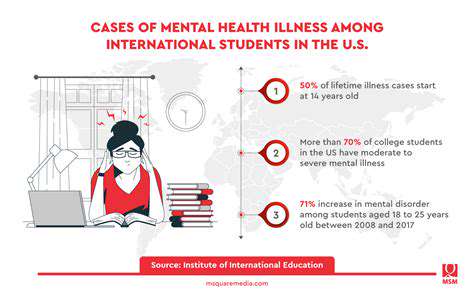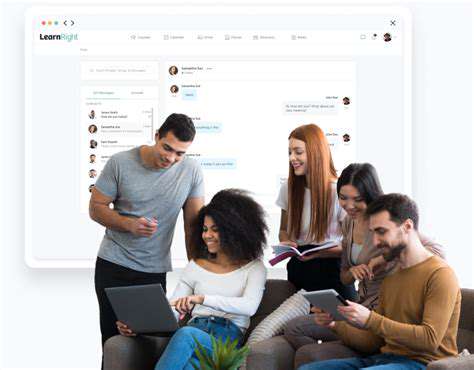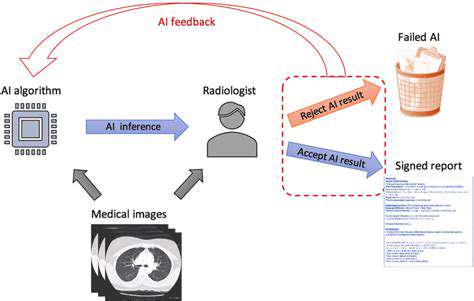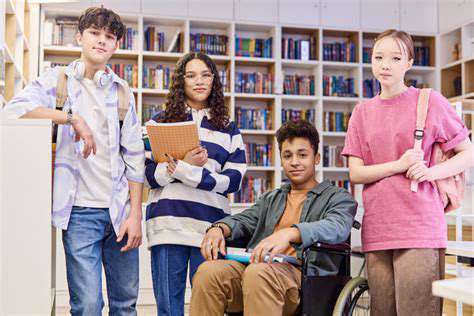Enhancing Engagement with Interactive Experiences
Immersive learning environments, particularly those leveraging augmented reality (AR), offer a powerful departure from traditional textbook-based instruction. AR overlays digital information onto the real world, creating interactive experiences that capture and maintain student attention. This engagement fosters deeper understanding and a more active role in the learning process, moving beyond passive reception of information towards active exploration and discovery.
Bridging the Gap Between Theory and Practice
AR applications can seamlessly bridge the gap between abstract concepts and tangible, real-world applications. Imagine a student studying anatomy. Instead of a static diagram in a textbook, they could interact with a 3D model of a human heart, rotating it, examining its different components, and even virtually dissecting it. This hands-on, interactive experience promotes a deeper comprehension of complex biological processes.
AR also allows students to explore historical events, visit distant landmarks, and even engage in simulations of scientific experiments, all within a safe and controlled environment. This experiential learning fosters a more concrete understanding of abstract concepts.
Personalized Learning Paths
AR-powered learning platforms can adapt to individual student needs and learning styles, creating personalized learning paths. By tracking student progress and identifying areas where they need more support, AR can tailor content and exercises to optimize knowledge acquisition. This individualized approach leads to a more efficient and effective learning experience for each student.
Accessibility and Inclusivity
Immersive learning environments can enhance accessibility and inclusivity in education. AR applications can provide alternative ways for students with disabilities to access and interact with learning materials, removing barriers and promoting equal opportunities for all learners. For example, visual aids and auditory cues can be integrated into an AR experience to cater to diverse learning styles and needs.
Promoting Collaboration and Communication
AR tools can facilitate collaborative learning experiences by allowing students to work together on projects in a shared virtual space. They can collaborate on building 3D models, creating virtual presentations, and engaging in interactive discussions, all while benefiting from the visual and interactive nature of the AR environment. Such collaborative activities foster communication and teamwork skills, essential for success in the modern world.
Cost-Effective and Sustainable Solutions
While initial investment in AR technology may seem substantial, the long-term cost-effectiveness of immersive learning environments can be significant. AR can reduce the need for expensive laboratory equipment and field trips, while providing engaging and interactive experiences that foster deeper understanding. Furthermore, the digital nature of AR can contribute to a more sustainable approach to education by reducing paper consumption and promoting digital literacy.
Interactive Learning Activities: Making Learning Fun
Enhancing Engagement with AR Games
Augmented reality (AR) games can significantly boost student engagement in learning. By overlaying digital content onto the real world, these games make learning more interactive and exciting. Students can explore historical sites, dissect virtual anatomical models, or even embark on virtual expeditions, all while experiencing a more dynamic and immersive learning environment. This interactive approach caters to diverse learning styles, fostering a deeper understanding and retention of concepts.
The gamified nature of AR learning activities often incorporates elements of competition and rewards, further motivating students to actively participate and master the subject matter. The thrill of discovery and the satisfaction of achievement can significantly increase motivation and create a more positive learning experience.
Virtual Field Trips: Exploring the World from Anywhere
AR technology allows for virtual field trips that transport students to various locations across the globe, without leaving the classroom. Imagine taking a virtual tour of the Egyptian pyramids, dissecting a virtual frog, or witnessing a simulated volcanic eruption. These immersive experiences provide a unique learning opportunity that bridges the gap between theory and practice.
Virtual field trips offer a cost-effective and accessible alternative to traditional field trips. They remove geographical barriers and allow students from diverse backgrounds to participate in learning experiences that may otherwise be inaccessible. This broadens their perspectives and fosters a deeper understanding of the world around them.
Interactive Simulations: Experiencing Concepts Visually
AR simulations allow students to experience abstract concepts in a tangible and interactive way. For example, students can virtually manipulate molecules to understand chemical reactions, or build virtual structures to grasp architectural principles. These simulations provide a hands-on approach to learning, enabling students to explore and experiment with concepts in a safe and controlled environment.
Interactive 3D Models: Exploring Complex Structures
AR applications can create interactive 3D models of complex structures, providing students with a unique perspective. Imagine students being able to rotate, zoom, and dissect a virtual human heart or a complex machine. This interactive approach to learning allows for a deeper understanding of intricate details and spatial relationships, improving comprehension and retention of the material.
AR Storytelling: Bringing History and Literature to Life
AR technology can be used to bring historical events and literary works to life. For instance, students can use AR apps to visualize historical figures in their historical settings, or interact with characters from a book, creating a more engaging and memorable learning experience. This immersive approach can make learning more relevant and meaningful to students.
Collaborative Learning Environments: Working Together Virtually
AR platforms can foster collaborative learning experiences, allowing students to work together on projects in a virtual environment. Students can virtually collaborate on building a virtual structure, simulating a scientific experiment, or creating a 3D model. This collaborative approach allows for diverse perspectives and promotes knowledge sharing, ultimately enhancing learning outcomes.
Assessment and Feedback: Personalized Learning Experiences
AR technology allows for more dynamic and personalized assessment and feedback mechanisms. Interactive quizzes, virtual experiments, and real-time feedback can be integrated into AR applications to provide students with immediate feedback on their learning progress. This personalized approach to learning allows for tailored support and encouragement, leading to improved student outcomes.
Personalized Learning Experiences: Tailoring Education to Individual Needs
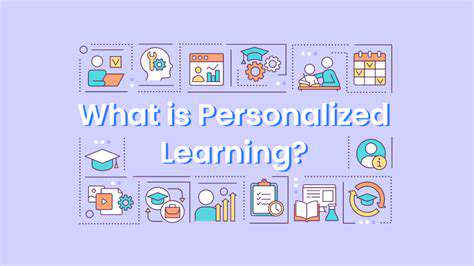
Tailored Instruction
Personalized learning experiences prioritize the unique needs and learning styles of each student. This approach goes beyond a one-size-fits-all curriculum, recognizing that individuals learn at different paces and possess varying strengths and weaknesses. By adapting instruction to meet these individual needs, educators can unlock a student's full potential. This approach fosters a more engaging and effective learning environment, leading to improved comprehension and retention.
Teachers can use formative assessments to identify areas where students are struggling or excelling. This allows them to adjust their teaching methods and materials accordingly. This dynamic and responsive approach promotes deeper understanding and a more meaningful connection to the subject matter.
Adaptive Learning Platforms
Adaptive learning platforms utilize technology to tailor the learning experience to each student's specific needs. These platforms adjust the difficulty and pacing of lessons in real-time, ensuring that students are constantly challenged at an appropriate level. This personalized approach can significantly enhance student engagement and motivation. By providing immediate feedback and targeted practice, these platforms help students solidify their understanding and overcome knowledge gaps efficiently.
Differentiated Instruction Strategies
Differentiated instruction acknowledges that students learn in diverse ways. It involves tailoring teaching methods, materials, and assessments to cater to the varying needs and learning styles of individual learners. This approach is crucial in creating an inclusive classroom where all students feel supported and empowered.
Implementing differentiated instruction requires teachers to be flexible and adaptable. It necessitates a willingness to modify teaching strategies to accommodate diverse learning needs. This commitment to inclusivity ultimately benefits all students, fostering a supportive and enriching learning environment for everyone.
Student Agency and Choice
Personalized learning empowers students by giving them a greater degree of control over their learning journey. This includes allowing students to choose topics, projects, and learning activities that align with their interests and goals. This sense of ownership and agency fosters intrinsic motivation and a deeper engagement with the subject matter. This approach encourages self-directed learning and critical thinking skills.
Personalized Feedback and Support
Providing personalized feedback is essential for fostering student growth and development. Regular, constructive feedback helps students understand their strengths and weaknesses and identify areas for improvement. Specific and actionable feedback, tailored to individual needs, empowers students to make progress and refine their skills. This individualized support can help students build confidence and resilience in their learning process.
Technology Integration for Personalized Learning
Technology plays a pivotal role in supporting personalized learning experiences. Educational apps, online resources, and interactive tools can be used to cater to diverse learning styles and needs. These resources can provide students with customized learning paths, tailored exercises, and personalized feedback. Utilizing these technologies effectively can enhance the learning experience for all students. The integration of technology can unlock opportunities for students to explore their interests and pursue their passions.
The Future of Education: Embracing AR Technology
Immersive Learning Experiences
Augmented reality (AR) is poised to revolutionize education by creating immersive and interactive learning experiences that traditional methods simply can't match. Imagine students dissecting a virtual human heart, exploring the intricacies of the solar system in a 3D model overlaid on their classroom, or even stepping into a historical event as if they were a participant. These opportunities for hands-on, engaging exploration will dramatically improve comprehension and knowledge retention. AR's ability to bring abstract concepts to life will be invaluable in fostering a deeper understanding and a more enthusiastic approach to learning.
The potential for personalized learning is also significant. AR applications can adapt to individual student needs, providing tailored support and reinforcement. By tracking student progress and identifying areas where additional support is needed, AR can help educators provide targeted interventions and create learning paths that best suit each student's unique learning style and pace. This personalized approach fosters a more inclusive and supportive learning environment, empowering each student to succeed.
Enhanced Engagement and Motivation
One of the most significant benefits of AR in education is its ability to enhance engagement and motivation. Traditional methods of instruction can sometimes be passive and lack the captivating visual and interactive elements that AR provides. By incorporating interactive games, simulations, and virtual field trips, AR transforms learning from a passive experience into an active, exploratory adventure. This increased engagement not only fosters a deeper understanding of the material but also creates a more positive and enthusiastic learning environment, ultimately boosting student motivation and enthusiasm for learning.
The interactive nature of AR fosters a sense of ownership and agency in the learning process. Students are no longer just passive recipients of information; they are actively involved in the exploration and discovery of knowledge. This active participation leads to a more profound and lasting understanding, as well as a greater intrinsic motivation to learn.
Personalized and Adaptive Learning
AR technology allows for a highly personalized learning experience, tailoring the educational content and pace to each student's individual needs. By tracking student progress and identifying areas where they are struggling or excelling, educators can adjust the curriculum and provide targeted support in real-time. This adaptive approach ensures that each student receives the specific instruction and reinforcement they require, fostering a more inclusive and effective learning environment. This personalized approach empowers students to learn at their own pace, addressing individual strengths and weaknesses.
Furthermore, AR can provide immediate feedback on student performance, allowing for continuous assessment and improvement. Interactive exercises and simulations can provide instant feedback on answers and performance, allowing students to identify their mistakes and correct them immediately. This iterative process fosters a culture of continuous learning and improvement, promoting a stronger understanding and mastery of the subject matter.
Transforming the Classroom Experience
AR has the potential to completely transform the traditional classroom experience, moving beyond the constraints of textbooks and lectures. Imagine classrooms equipped with interactive displays and augmented reality overlays that bring historical events, scientific phenomena, or complex concepts to life. AR applications can create dynamic and engaging learning environments that are both inspiring and effective. This technology promises to revolutionize the way teachers present information and students absorb it, leading to a more exciting and captivating learning experience.
AR can also extend learning beyond the confines of the classroom. Virtual field trips, interactive simulations, and access to remote experts can all be integrated into the curriculum, enriching the learning experience and opening up new possibilities for exploration and discovery. AR technology is poised to foster a more dynamic and engaging learning environment, paving the way for a future where education is more accessible, interactive, and enriching for all.
